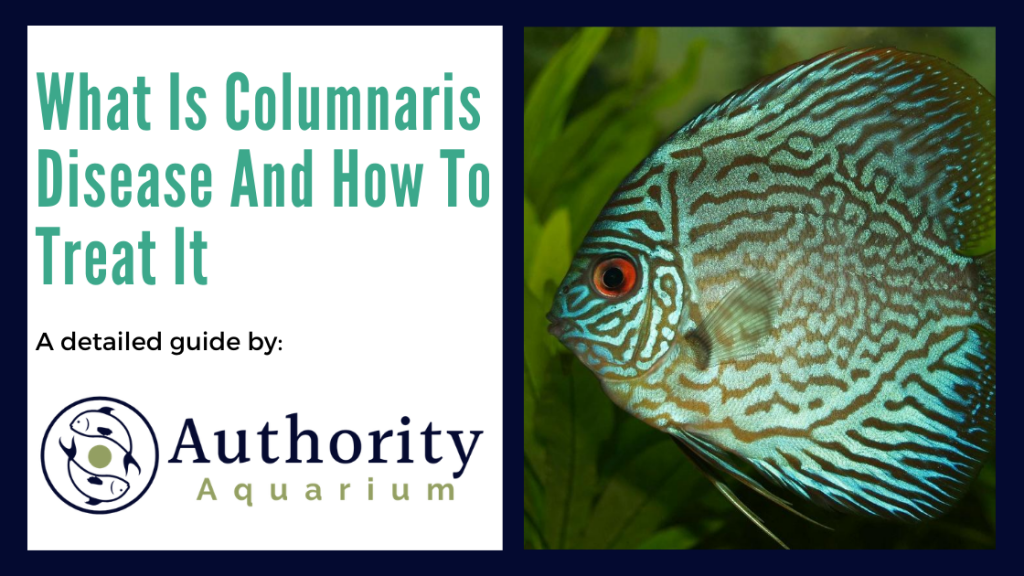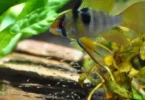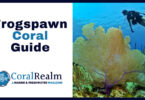Last Updated on April 24, 2023 by Coral Realm
Columnaris Disease is also commonly known as mouth fungus, mouth rot, and saddleback disease. It is the rotting of the fish’s mouth caused not by a fungus as the common name suggests, but by a high concentration of a harmful, rod shaped bacteria known as Flavobacterium columnare; it is a fast acting bacterial infection that is known to kill 50% of the population is 2-3 days, therefore it should be treated as soon as any symptoms arise.
This bacterium has two main strains, and it can cause acute or chronic infection. An acute infection can kill aquarium fish in a matter of hours, and you most likely won’t see the symptoms before your fish die. In chronic infections however you can give your fish a fighting chance as it can take days for the infection to kill your fish.
It is a freshwater warm water disease, and isn’t found in cold climates or in saltwater. It can be found in aquariums and fish ponds alike.
IN THIS ARTICLE
What Is Columnaris Disease And How To Treat It

Causes:
As fish rely on their mouths for most behaviors including feeding, fighting and foraging, the majority of injuries occur in or around their mouths; this allows any surrounding bacteria to get in the wound and begin the spread.
It is important to realize that all freshwater aquariums will contain the columnaris disease bacteria. In fact all fish tanks contain a low concentration of harmful bacteria, and fish that are correctly cared for are able to prevent the bacteria from entering their body.
However those that are in a neglected environment will be surrounded by a higher amount of this bacteria, that their immune systems cannot fight off; this can include old faeces, food and old substrates.
Stress is the number one cause of most infections in fish tanks, whether it be bacteria, viral, or fungal.
The bacterium F. columnare thrives in high temperatures, so is much more common in tropical tanks. If you have a high fish density as well, this can increase the likelihood and spread of the infection.
Symptoms:
In the early stages of this bacterial infection you may notice that your fish’s lips will begin to form a white outer layer that has a lipstick appearance, when the bacteria begins to spread and the disease worsens the following symptoms may appear:
- A mould like substance will cover the lips and will begin to rot them away.
- A white film appearing on their skin and gills. If the gills are affected the fish will have trouble taking in oxygen, so will be less active and will breathe rapidly.
- Missing scales
- Eroding fins. The lesions and white film can also extend down the sides of the fish, giving the fish its ‘saddle-back’ appearance.
Prevention and Treatment:
The only prevention for the spread of this bacterial disease is regular cleaning and maintenance of the fish tank to stop any harmful bacteria from multiplying. This includes gravel cleaning, water changes of 25%, removing any old food or debris and removing algae off the glass. An aquarium vacuum cleaner is a very good idea, as you can remove waste and clean the substrate easily.
If you think you have an infection in your tank, make sure you disinfect the vacuum cleaner after each use, and anything else that you use to clean the tank. This will prevent you accidentally reinfecting your tank.
Stress is a major cause of disease, so make sure to regularly test the water quality of your aquarium. Also ensure they are fed the correct amount, and that they have enough hiding places.
As the bacterium likes higher temperatures, lowering the temperature will help to slow the spread. Be very careful in lowering the temperature though, as rapid drops will only make your fish worse. Make sure you have a good aquarium thermometer to measure the change, and lower the temperature VERY gradually. Using a good aquarium heater will allow you to further control the temperature. Ideally you want the temperature to be below 75˚F.
Isolating infected fish in a quarantine tank is a good idea and may have an impact in slowing the spread, as they won’t be able to directly infect other fish, but do still treat the main tank.
In order to treat Columnaris, antibiotic treatments are available to kill the bacteria and aid in the healing process, as well as water treatments. Copper sulfate can be effective, as can adding salt into the water. But do err on the cautious side while using salt as some fish are very intolerant to salty conditions.
Treatments
Fish are best treated with a combination of the antibiotics nitrofurazone and kanamycin, which can be administered together synergistically to provide a double edged sword in fighting this infection.
You ideally want to administer both of these antibiotic treatments while also undertaking water changes. You should follow the instructions on the reverse of the API Furan-2 packet, while also adding the dose of the Seachem medication.
While these antibiotic treatments will most likely work best, you can also look at the following as options:
API Melafix
- Rapidly repairs fins, ulcers, and open wounds.
- Promotes regrowth of damaged tissue and fins.
This product safely treats all bacterial infections and contains natural Tea Tree extracts to aid in the healing process. It helps to repair damaged fins, ulcers, and open wounds.
You should use this product daily whilst trying to treat Columnaris Disease. It can also be used in conjunction with API Pimafix, which contains natural extracts from West Indian Bay Trees to aid in the treatment of internal and external bacterial infections.
Api Aquarium Salt
This aquarium salt can be added to your freshwater aquarium to treat Columnaris Disease.
It promotes fish health and disease recovery by increasing electrolytes in the water and improves respiration.
Adding salt into a freshwater aquarium infected with Columnaris Disease lowers the osmotic stress which the fish suffer due to the bacteria damaging the gills.
This salt is made using evaporated sea water for a more natural product.
Conclusion
The bitter truth is that Columnaris Disease has a very high death rate. As with most diseases the best treatment is to prevent it from occurring in the first place!
Make sure you monitor the conditions in your tank, and ensure you keep the temperature, hardness, and ammonia and nitrate levels are in the correct ranges. Also ensure you clean the tank regularly and have a well functioning filter. Triple stage filtration is the gold standard of filtration, where all three of mechanical, chemical, and biological filtration are present. HOB filters such as the Fluval C4 offer this and more, as do canister filters such as the Fluval FX6 and Penn Plax Cascade.
Also ensure you have plants in your aquarium. They provide natural filtration, and also give your fish somewhere to hide, especially if they are smaller fish. All this will reduce stress levels in your fish, which helps to prevent them from contracting diseases.
If you are unlucky and find Columnaris in your tank, work quickly!! Try and isolate the sick fish, and treat your tank with the antibiotic combination found in API Furan-2 and Seachem KanaPlex.
Also see our articles on Camallanus and White Spot Disease for more fish disease guides and treatment.










